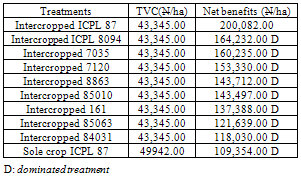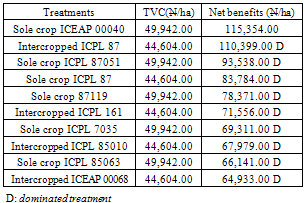-
Paper Information
- Next Paper
- Previous Paper
- Paper Submission
-
Journal Information
- About This Journal
- Editorial Board
- Current Issue
- Archive
- Author Guidelines
- Contact Us
International Journal of Agriculture and Forestry
p-ISSN: 2165-882X e-ISSN: 2165-8846
2012; 2(1): 108-114
doi: 10.5923/j.ijaf.20120201.17
Evaluation of Pigeonpea Genotypes for Intercropping with Maize and Sorghum in Southern Guinea Savanna: Economic Benefits
Moses O. Egbe 1, Joseph A. Idoko 2
1Department of Crop Production, University of Agriculture, Makurdi, Nigeria
2Department of Agricultural Science Education, University of Agriculture, Makurdi, Nigeria
Copyright © 2012 Scientific & Academic Publishing. All Rights Reserved.
The economics of production and profitability of intercropped pigeonpea [Cajanus cajan (L.) Millsp] genotypes with maize [Zea mays L.] and sorghum [Sorghum bicolor (L.) Moench] were studied in two separate field experiments in 2007 and 2008. Each experiment was a 2 x 15 factorial set out in split plot design in three replications with the main objective of evaluating the economic potentials of recently introduced pigeonpea genotypes from International Crops Research Institute for Semi-Arid Tropics (ICRISAT) with a view to increasing and diversifying household income in Southern Guinea Savanna of Nigeria. Though it depressed pigeonpea grain yields, intercropping consistently gave higher net benefits than sole cropping in the pigeonpea/maize systems. ICPL 87 gave the highest net benefits in both pigeonpea/maize and pigeonpea/sorghum intercropping systems (N200, 082.00/ha and N110, 399.00/ha respectively). It also produced the highest marginal rate of returns and returns per naira investment in the pigeonpea/maize systems. Sole pigeonpea was more remunerative than many intercropped pigeonpea with sorghum. Most of the new varieties proved superior to the Farmer’s variety in both cropping systems, with consequent higher profitability. This implies potential increase in household incomes and alternative farm enterprise with the adoption of any of these new varieties in the intercropping systems studied.
Keywords: Intercropping, Pigeonpea, Net Benefits, Marginal Rate of Returns
Cite this paper: Moses O. Egbe , Joseph A. Idoko , "Evaluation of Pigeonpea Genotypes for Intercropping with Maize and Sorghum in Southern Guinea Savanna: Economic Benefits", International Journal of Agriculture and Forestry, Vol. 2 No. 1, 2012, pp. 108-114. doi: 10.5923/j.ijaf.20120201.17.
Article Outline
1. Introduction
- Globally pigeonpea ( Cajanus cajan (L.) Millsp) is the fifth most important pulse crop mainly grown in the developing countries by resource-poor farmers in drought prone areas and on degraded soils. It is a multipurpose leguminous crop that can provide food, fuel wood and fodder for the small-scale farmer in subsistence agriculture (Tabo et al.,1995;Egbe,2005).Pigeonpea is a deep-rooted and drought tolerant grain legume that adds substantial amount of organic matter to the soil (Egbe,2005) and has the ability to fix up to 235 kg N/ha (Peoples et al., 1995) and produces more N per unit area from plant biomass than many other legumes. Pigeonpea has been reported to fix between 36.10 and114.04 kg N/ha when intercropped with maize and 35.94-164.82 kgN/ha under intercropping with sorghum at Otobi (Egbe, 2007). In Southern Guinea Savanna agro-ecological zone of Nigeria, where poverty level is high and income generation opportunities are few, pigeonpea is often grown as field crop in both sole and intercropping systems with maize and sor ghum (Egbe, 2005; Egbe and Kalu, 2006). Intercropping popularity among small-scale farmers in Benue, Kogi, Nasarawa, Taraba and Kaduna States of Nigeria, probably because of its multiple-end uses, despite low yields (0.5-1.0 t/ha) under the traditional cropping systems.Estimation of farm income benefits provides an alternative measure of potentials for various intercropping combinations (Anders et al.,1996).Some workers had estimated benefits that accrued to pigeonpea producers as farm income by calculating the monetary advantage (Rafey and Prasad,1992) or by estimating the net returns (Ramakrishna et al., 2005; Marer et al., 2006; Guedes and Araujo,2010). Egbe (2010) had estimated economic benefits of intercropped soybean with sorghum by calculating gross returns, net returns, and returns per naira investment, soybean equivalent ratio and marginal rate of returns. Information on the biological efficiencies of intercropping pigeonpea with sorghum and maize in Nigeria are available (Egbe, 2005; Egbe and Adeyemo, 2006; Egbe and Bar- Anyam, 2011), but there is dearth of documented information on the economic benefits of these intercropping systems in the Southern Guinea agro- ecological zone of Nigeria. The work reported here was undertaken to document the economic benefits of intercropping some newly introduced improved pigeonpea genotypes with maize and sorghum in Southern Guinea Savanna of Nigeria with a view to increasing and diversifying household incomes of farmers in the region.
2. Materials and Methods
- Two separate field experiments were set up in 2007 and 2008 at the National Root Crops Research Institute Sub- Station,Otobi (07o 10∕ N,08o 39∕ E, elevation 105.1 m) in Benue State, located in Southern Guinea Savanna of Nigeria (Kowal and Knabe,1972).The objectives of the experiments were to estimate the economic benefits of intercropping improved pigeonpea genotypes separately with maize and sorghum. These pigeonpea genotypes obtained from International Crops Research Institute for Semi-Arid Tropics (ICRISAT), India, were recently introduced to farmers in Benue State, Nigeria. The experimental site received a total rainfall of 1712.00 mm and 1665.60 mm, respectively, within the period of June-November, 2007 and 2008. The soil at the experimental site was classified as Typic Paleustaff (USDA).Ten core soil samples were taken randomly from the experimental site and bulked into a composite sample for physical and chemical analysis at the National Vertinerary Research Institute, Vom near Jos, Nigeria in each year of the experiment. The soil was characterized as sandy-loam with pH of 7.60 (H2O). Total nitrogen, available phosphorus (Bray 1) and potassium values were 350, 36,122 mg kg-1 soil, respectively, in 2007. In 2008, the soil was similarly characterized as sandy loam with pH of 6.90(H2O), total nitrogen, available phosphorus (Bray 1), and potassium values were 510, 51,150 mg kg-1, respectively.
2.1. Experiment 1: Pigeonpea/Maize Intercropping
- The experiment was 2 x 15 split-plot laid out in randomized complete block design with three replications. Cropping systems at two levels [sole cropping (pigeonpea ,maize) and intercropping (pigeonpea + maize) constituted the main plot treatments, while 15 pigeonpea genotypes of different maturity groups [ICPL 85010,ICPL 84031,ICPL 87,ICPL 161 (short duration),ICPL 8863,ICPL 85063,ICPL 87119,ICPL 7120,,ICEAP 00068 (medium duration),ICPL 7035,ICPL 8094,ICPL 87051,ICPL 9145,ICEAP 00040 (long duration) and the Farmers’ variety] including a local check constituted the sub-plot treatments. The maize variety used was the Striga-tolerant CY TZL.COMP.1C4 obtained from the International Institute for Tropical Agriculture (IITA), Ibadan, Nigeria.The gross plot comprised of 3 ridges spaced 1 m apart and 4 m long (12 m2),while the net plot was made up of the middle ridge (4 m2). Land preparation was done manually using traditional implements. Pigeonpea was planted at a spacing of 1 m x 0.3 m with three seeds per hole and later thinned to two plants/stand (66,666 plants /ha),while the maize was planted at a spacing of 1 m x 0.5 m with three seeds per hole and later thinned to two plants/stand (40,000 plants/ha). The same population of pigeonpea and maize were maintained in both intercrop and sole crop treatments. Intercropping had a 1:1 (pigeonpea: maize) row proportion. In the intercrop treatments, both pigeonpea and maize were planted on the same ridge. Pigeonpea occupied the crest of the ridge, while maize was planted on the side. Both crops were planted on the same day, on 23rd and 24th June 2007 and 2008, respectively. All plots received a basal application of 100 kg of NPK: 15:15:15 at the rate 15 kg N, 6.45 kg P and 12.45 kg K per hectare (ha) by broadcasting. The sole and intercropped maize were top-dressed four weeks after planting (w.a.p) with 46 kg N/ha by opening the soil around each plant and banding at 5-8 cm depth and covering with the dug-out soil. Two manual weeding were done at 3 w.a.p. and 6 w.a.p., respectively. Data on grain yields of pigeonpea and the grain yield of maize were collected at harvest for analysis.
2.2. Experiment 2: Pigeonpea/Sorghum Intercropping
- The experimental site was separated from that of Experiment 1 by a distance of 10 m. The pigeonpea genotypes used, land preparation methods, experimental design, planting methods and dates, spacing, crop husbandry practices and procedures for data collection were the same as adopted in Experiment 1. The sorghum cultivar used in this experiment was the tall, photoperiod-sensitive red sorghum commonly used by the farmers in Southern Guinea Savanna. Data on grain yields of both pigeonpea and sorghum components were collected for analysis.In both experiments, application of insecticide to check pod borers was need-based.
2.3. Economic Performance of Pigeonpea/Maize and Pigeonpea/Sorghum Intercropping
- The economic performance of the intercropping systems were evaluated to decide if grain yields of intercropped pigeonpea with maize and sorghum in 2007 and 2008 at Otobi and additional maize and sorghum yields justified adoption of this intercropping system by farmers in Southern Guinea Savanna of Nigeria. Total variable cost (TVC) and net benefits were computed as described by Egbe (2010). Returns per naira invested (RI) was computed as RI = gross returns ⁄ TVC. The higher the value of RI the more profitable is the cropping system. Furthermore, the economic analysis was carried out as described by CIMMYT (1998) to estimate the marginal rate of returns. A dominance analysis was done and the non-dominated treatments were further subjected to marginal rate analysis. For the dominance analysis, only the top ten treatments (i.e., treatments with the highest computed net benefits) were used. The local market price of pigeonpea, maize and sorghum per kg in 2008 and 2009 were N150, N120, and N100 (Nigerian naira) which are equivalent to 1.25, 1.00 and0.83 USD respectively. The Nigerian naira values were used to obtain the calculated cash values.
2.4. Statistical Analysis
- Data collected were analyzed using GENSTAT Release 11.1 (PC/Windows) (2008 VSN International Ltd., London) and standard errors of differences of means (Sed) were used to compare treatment means. Student’s t-test was used to compare values of economic parameters (TVC, net benefits and RI) of pigeonpea/maize and pigeonpea/sorghum intercropping systems. Year x treatment effects were not significant and so results of both years were pooled before analysis.
|
3. Results
- The yield of pigeonpea genotype varied with the cropping systems adopted (Table 1). Generally, intercropping depressed the yield of pigeonpea. However, some genotypes (ICPL 85010, ICPL 161 and ICPL 7120) had higher significant yield under intercropping than in sole cropping in the pigeonpea/maize systems. ICPL 87 produced the highest mean yield in both pigeonpea/maize and pigeonpea/sorghum cropping systems. While ICEAP 00040 gave the lowest yield (1.29 t/ha) in the pigeonpea/maize cropping systems, ICPL 7120 did so in pigeonpea/sorghum systems. There was no significant difference between pigeonpea/maize and pigeonpea/sorghum in the grain yields of pigeonpea produced (Table 1).Intercropped maize and sorghum with ICPL 8863 produced the highest grain yields of both maize (3.43 t/ha) and sorghum (3.21 t/ha) (Table 2). Grain yields of the cereal components of the pigeonpea/maize and pigeonpea/sorghum were similar (Table 2).Only two intercrop combinations (ICPL 85063 + sorghum and ICEAP 00068 +sorghum) gave cereal yield figures of less than 2.0t/ha; all the other combinations had above 2.0 t/ha (Table 2).
|
|
 | Figure 1. Net benefits of pigeonpea/maize intercropping systems at Otobi |
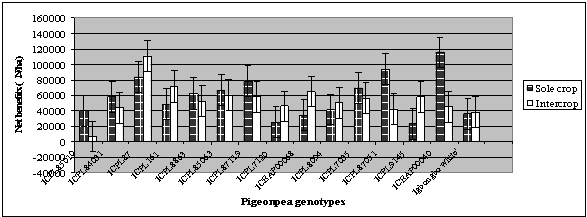 | Figure 2. Net benefits of pigeonpea/sorghum intercropping systems at Otobi |
|
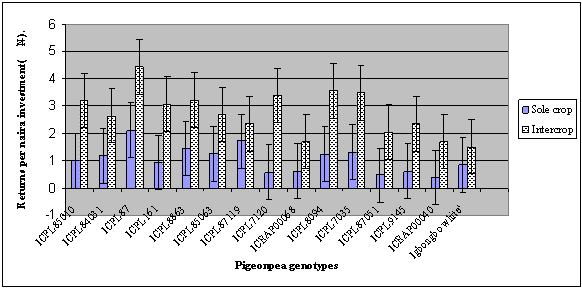 | Figure 3. Returns per naira investment of pigeonpea/maize intercropping systems at Otobi |
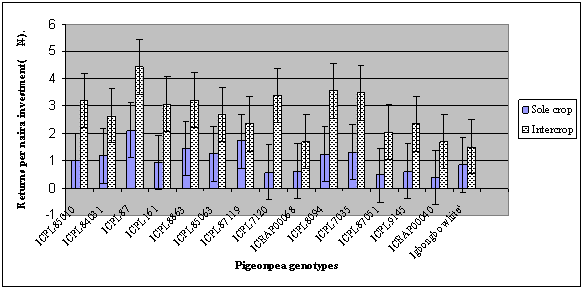 | Figure 4. Returns per naira investment of pigeonpea/sorghum intercropping systems at Otobi |
|
|
4. Discussion
- The depression in the grain yields of intercropped pigeonpea treatments as compared to sole crop resulted from decline in plant height, dry pod weight and total plant biomass (data not shown) of the pigeonpea component due to inter-specific competition. The taller cereal components (maize and sorghum) grew faster at the early stages and shaded the slower growing pigeonpea, lowering photosynthetic activities of the pigeonpea. Similar observations have been made in earlier studies (Egbe and Adeyemo, 2006; Dasbak and Asiegbu, 2009).These authors opined that inter- specific competition for light, nutrients, water, air and other growth resources often resulted in depressed yields of the intercrop components. The higher TVC observed for sole pigeonpea as compared to intercrop could be ascribed to higher labour costs for picking the sole crop. The higher TVC of intercropped pigeonpea with sorghum than pigeonpea with maize was attributed to higher labour costs for harvesting, threshing and winnowing sorghum than maize. The greater net benefits and RI that accrued to pigeonpea/ maize intercropping as compared to the sole crop derived principally from the additional high yields and values of the maize component. Some authors have reported higher income and benefits of pigeonpea intercropping; especially when new pigeonpea lines were introduced into the maize cropping systems ( Marer et al., 2007; Dasbak and Asiegbu, 2009). Sanginga and Woomer (2009) had stated in their work on integrated soil fertility management in Africa, that pigeonpea/maize intercropping in Malawi had and could improve farm income by 50-70% compared to continuous maize cultivation. Sole pigeonpea seemed to have been more remunerative than pigeonpea/sorghum intercropping probably because of intense inter-specific competition from the sorghum component that lowered intercrop yields and subsequently reduced profits. Sorghum is endowed with unique proliferation of robust fine root network equipped for better competition for below-ground growth resources than pigeonpea. Also, the sorghum variety used was long duration and this prolonged the period of competition between the component crops. Anders et al. (1996) had stated that successful intercropping combinations are often times those that capitalize on both spatial and temporal complimentarity, thus resulting in an overall increase in light intercepted by the system during a season. The better performance of ICPL 87 than the other genotypes in both intercropping systems in terms of grain yields, net benefit, RI and returns per naira investment may stem from its aggressive early growth, early maturity and profuse pod production several times in a production season. The dominance analysis indicated that it is important to pay attention to net benefits, rather than yields. The marginal rate analysis revealed that the two intercropping systems were profitable and the introduction of the new genotypes enhanced productivity and profitability of the pigeonpea/cereal intercropping systems in the region, especially the pigeonpea/maize intercropping. To minimize competition in the pigeonpea/sorghum intercropping and enhance profitability, reduction of the sorghum density may be considered for investigation.
5. Conclusions
- Intercropping pigeonpea with maize consistently resulted in higher net benefits, marginal rate of returns and returns per naira investment than sole cropping. The trend in pigeonpea/sorghum was erratic, although several genotypes showed promise. Sole pigeonpea was more remunerative than intercropped pigeonpea with sorghum. Most of the new varieties proved superior in both cropping systems than the farmer’s variety, with consequent higher profitability, suggesting potential increase in household incomes and alternative farm enterprise with adoption of any of these intercropping systems.
References
| [1] | Anders, M.M., Potdar, M.V., Francis, C.A.,1996,Significance of intercropping in cropping systems, Ito et al.,Eds. Roots and nitrogen in cropping systems of the semi-arid tropics,Japan,Ibaraki 305, pp1-18 |
| [2] | Dasbak, M.A.D.,and Asiegbu, J.E., 2009, Performance of pigeonpea genotypes intercropped with maize under humid tropical ultisol conditions.,Journal of Animal and Plant Sciences 4(2), 329-340 |
| [3] | CIMMYT, 1998, From Agronomic data to Farmer Recommendations: An Economics Training Manual, Completely revised edition, Mexico, DF |
| [4] | Egbe, O.M., 2005, Evaluation of some agronomic potential of pigeonpea genotypes for intercropping with maize and sorghum in Southern Guinea Savanna.Ph.D. Thesis, University of Agriculture, Makurdi, Nigeria |
| [5] | Egbe, O .M., 2007, Assessment of biological nitrogen fixing potentials of pigeonpea genotypes intercropped with sorghum for soil fertility improvement in Southern Guinea Savanna of Nigeria. Agro-Science, 6 (1), 33-45 |
| [6] | Egbe, O.M., 2010, Effects of plant density of intercropped soybean with tall sorghum on competitive ability of soybean and economic yield at Otobi, Benue State, Nigreia., Journal of Cereals and Oilseeds,1(1), 1-10 |
| [7] | Egbe, O.M., and Kalu, B.A., 2006, Farming Systems Study: Participatory Rural Appraisal of pigeonpea cropping systems in Southern Guinea Savanna of Nigeria., Journal on Environment (Abia State University Environmental Review), 5 (1), 37-47 |
| [8] | Egbe,O.M., and Adeyemo, M.O, 2006, Estimation of the effect of intercropped pigeonpea on the yield and yield components of maize in Southern Guinea Savanna of Nigeria. Journal of Sustainable Development in Agriculture and Environment 2 (1), 107-118 |
| [9] | Egbe, O.M.and Bar-Anyam, M.N, 2010, Pigeonpea/sorghum intercropping in Southern Guinea Savanna: effects of planting density of pigeonpea, Nature and Science,8(11), 156-167 |
| [10] | Guedes, R., and Araujo, F.P., 2010, Forage production for smallholder farmers in the semi-arid region of Brazil.,Proc.19th World Congress of Soil Science,Soil Solutions for a changing world, Brisbane, Australia, pp 175-178, Aug.2010 |
| [11] | Kowal, J.M., and Knabe, D.T, 1972, An agroclimatological atlas of the Northern States of Nigeria with explanatory notes. Ahmadu Bello University Press, Zaria |
| [12] | Marer,S.B.,Lingaraju,, B.S, and Shashidhara, G.B.,2007, Productivity and economics of maize and pigeonpea intercropping under rainfed condition in Northern Transitional Zone of Karnataka.,Karnataka Journal of Agricultural Sciences, 20 (1),1-3 |
| [13] | Rafey, A., and Prasad, N.K., 1992, Biological potential and economic feasibility of maize (Zea mays) + pigeonpea (Cajanus cajan) intercropping system in dry lands, Indian Journal of Agricultural Sciences, 62(2),110-113 |
| [14] | Ramakrishna, A., Wani, S.P, Srinivasa Rao, Ch., and Srinivas, Reddy,U, 2005, Effect of improved crop production technology on pigeonpea yield in resource poor rainfed areas, An Open Access Journal published by ICRISAT,1(1),1-3 |
| [15] | Sanginga, N., and Woomer, P.L.Eds.,2009, Integrated Soil Fertility Management in Africa: Pinciples,Practices and Developmental Process,Tropical Soil Biology and Fertility Institute of International Centre for Tropical Agriculture,Nairobi,Kenya,263 pp |
| [16] | Tabo, R., Ezueh, M.I, Ajayi, O.,Asiegbu, J.E. and Singh, L.,1995, Pigeonpea production and utilization in Nigeria, International Chickpea Pigeonpea Newsletter,No.2,pp47-49 |
 Abstract
Abstract Reference
Reference Full-Text PDF
Full-Text PDF Full-Text HTML
Full-Text HTML
